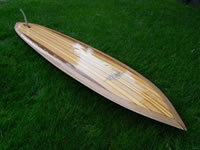Paul Jensen Interview
As part of our mission to explore the meaning of sustainability in the surfing industry, we will be conducting some short interviews with some of the people doing the most innovative construction using sustainable or environmentally friendly alternatives.
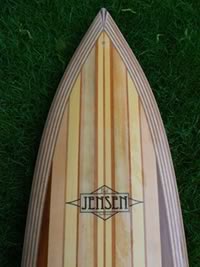 Our first interview is with Paul Jensen. Many of you may know Paul from Swaylock’s Surfboard Design Forum. Paul is regarded as one of the best hollow wood surfboard builders in North America. He has been perfecting his craft for quite some time and has openly shared much of his technique on the Swaylock’s forum.
Our first interview is with Paul Jensen. Many of you may know Paul from Swaylock’s Surfboard Design Forum. Paul is regarded as one of the best hollow wood surfboard builders in North America. He has been perfecting his craft for quite some time and has openly shared much of his technique on the Swaylock’s forum.
Paul has a lot of great information on his website about the boards, how they respond in the surf, durability, care, and aesthetics. We recommend that you read through his website to get more details about his construction methods. You can view Paul Jensen’s site at www.hollowsurfboards.com
And now for our short interview:
Q. Several people in North America are making high performance hollow wood boards. Wood boards are more expensive than a traditional foam board because of the craftsmanship. But they are also much more durable, making them long-term investments that pay for themselves after a few years. Do you think then that the type of boards you are making could become a regular sight in the lineup?
“With the amount of interest I’m getting about folks building their own hollow TO RIDE, I think it’s only a matter of time for that to happen…”
Q. One thing that seems to be missing in modern surf culture is that do-it-yourself attitude that existed in surfing in the early days. Can you talk a little about some of trials and success of making your own equipment?
“Like a lot of guys, my first shape was a reshape of a broken board. I did that when I was sixteen. I shaped my first real board when I was in my twenties. Since then I’ve made all my own stuff. After shaping close tolerance blanks, they got boring, so I thought I’d try a wood board. Using the basic Tom Blake theory, I modified it to a contemporary template with a modern rocker and shapeable rails. I kind of made up the process as I went along.
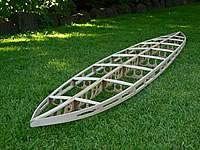 The basic frame and skins went fine; then the real challenge of gluing on rails began. First I tried to glue on strips of red cedar, but there was so much tension and spring back, they just wouldn’t stay glued to the tighter curves. After two days work I didn’t like how it was turning out so I peeled off all that work. Next I tried to lay up some strips vertically. Again another two days progress with less than acceptable results. I removed that stuff too. Exasperated that I was so close yet nothing was working, I was ready to abandon the idea and go back to foam.
The basic frame and skins went fine; then the real challenge of gluing on rails began. First I tried to glue on strips of red cedar, but there was so much tension and spring back, they just wouldn’t stay glued to the tighter curves. After two days work I didn’t like how it was turning out so I peeled off all that work. Next I tried to lay up some strips vertically. Again another two days progress with less than acceptable results. I removed that stuff too. Exasperated that I was so close yet nothing was working, I was ready to abandon the idea and go back to foam.
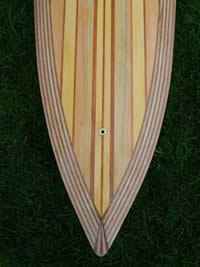 Finally I thought I’d try 1/8″ plywood. Layer after layer, clamps at the nose and tail, slow progress. Finally it looked right, now to shape the rails and not screw it up. I used a belt sander for the first time with great results. Glassing went smoothly and it’s all history from there.
Finally I thought I’d try 1/8″ plywood. Layer after layer, clamps at the nose and tail, slow progress. Finally it looked right, now to shape the rails and not screw it up. I used a belt sander for the first time with great results. Glassing went smoothly and it’s all history from there.
I went on to do all sheet cork rails, easy but they look like sausage. Next, cork and plywood rails, mo’ bettah -the techniques developed, the shapes became un-apologetic, and finally the weight can rival foam. And the ride is unbelievable, and to me, that’s what it’s all about…!!!…”
Q. Part of beginning a dialog about sustainability involves understanding what the concept is exactly and how it relates to surfing. By using organic materials like wood you are making a much more sustainable product than the traditional poly board. What does sustainability mean to you and how do you apply it in your work?
“Here’s where it gets important. Sustainability to me means managing resources in a way that ensures they will be available forever. But not at the expense of equally important products such as crops. I think a lot of the current lumber management practices in my part of the world are done with sustainability in mind. When I moved to the Pacific Northwest in 1990, the sight of a clear-cut was shocking. When I learned more about the re-planting and grow-back schedule it made sense. Sure there are problems with clear-cutting acres at a time, but we are a society that demands wood products. It would be better if we as a culture looked at the huge excesses in our lives and made changes to those hoarding and consuming ethics. The main problem I see with the clear cutting is the replacement of a diverse forest with a mono species. One insect blight, and the crop could easily be destroyed, but that could happen with a forest fire too.
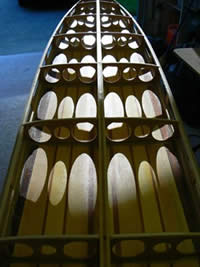 In my work, I have access to wood harvested from a variety of sources. The easiest and least sustainable /environmentally friendly is the stuff at the lumberyard, plywood in particular. A lot of the wood I use is leftover from deck or cabinet projects, re-using what might get thrown away. The best wood, and the absolutely most environmentally friendly stuff, is wood harvested from driftwood. Clear grained, old growth cedars and spruces, fallen and washed to sea, returned to a beach to either rot slowly or be used for special projects. This wood I’m speaking of I get from a private island in Canada, accessible only by boat or floatplane. There is ton’s of it up there. The other sustainable product I use is cork, the bark from the cork oak, grown specifically for its bark, harvested about every five years, sustainable in the best way.
In my work, I have access to wood harvested from a variety of sources. The easiest and least sustainable /environmentally friendly is the stuff at the lumberyard, plywood in particular. A lot of the wood I use is leftover from deck or cabinet projects, re-using what might get thrown away. The best wood, and the absolutely most environmentally friendly stuff, is wood harvested from driftwood. Clear grained, old growth cedars and spruces, fallen and washed to sea, returned to a beach to either rot slowly or be used for special projects. This wood I’m speaking of I get from a private island in Canada, accessible only by boat or floatplane. There is ton’s of it up there. The other sustainable product I use is cork, the bark from the cork oak, grown specifically for its bark, harvested about every five years, sustainable in the best way.
Unfortunately a durable and cosmetically acceptable, resin/fiberglass alternative is not available yet. The search goes on…”
Q. Shaping machines, pop-outs, close tolerance blanks… what will happen to the craftsman tradition? Where do you see the role of the craftsman/shaper in surfing in the next few years?
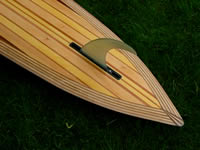 “The greatest loss with the mass production process is the development of the shaper. Many of the great surfboard designers all evolved from the mentorship process. With techniques and designs handed from designer/shaper to apprentice. With boards being made not by surfers, but by “factory workers,” where will the innovative design changes come from? One hope is that websites like www.swaylocks.com will be there for us out of the box thinkers.”
“The greatest loss with the mass production process is the development of the shaper. Many of the great surfboard designers all evolved from the mentorship process. With techniques and designs handed from designer/shaper to apprentice. With boards being made not by surfers, but by “factory workers,” where will the innovative design changes come from? One hope is that websites like www.swaylocks.com will be there for us out of the box thinkers.”
Q. Any last words of advice for our readers?
“Take your work seriously, but never take yourself too seriously.”
